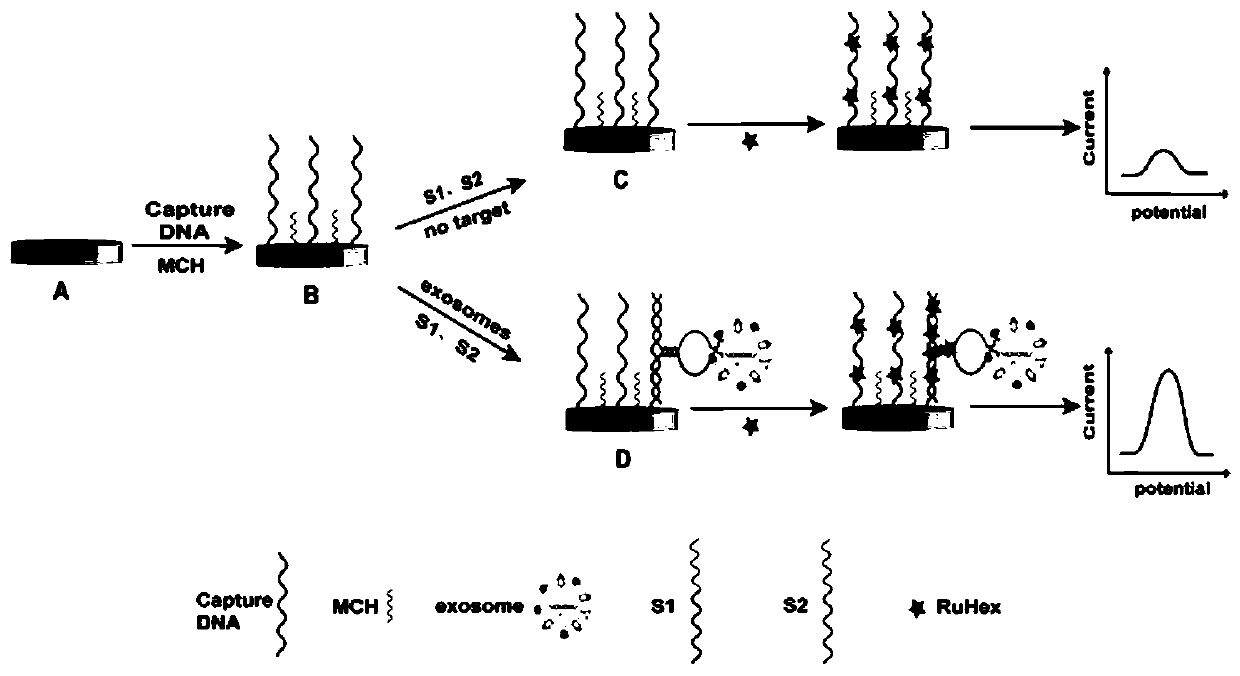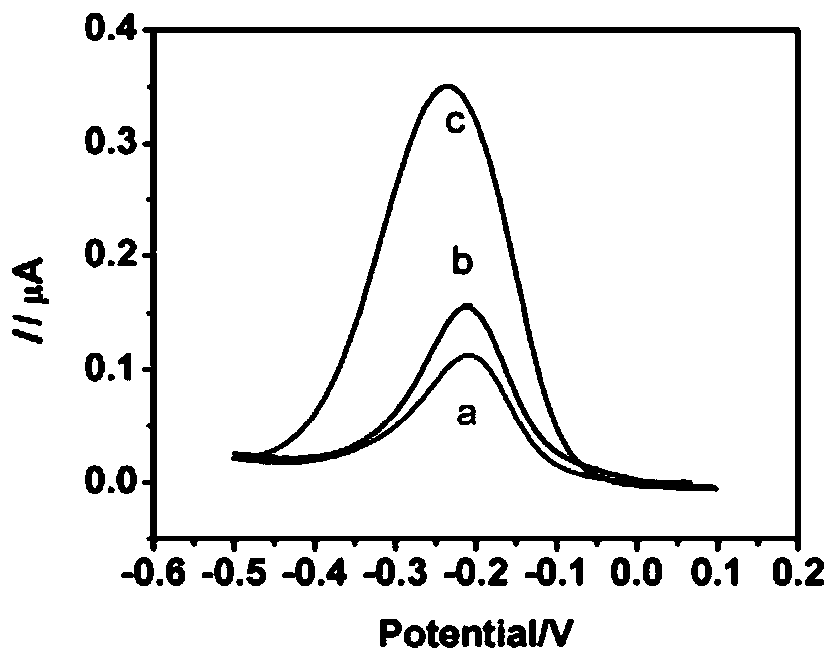Electrochemical sensor based on short-distance hybridization of split aptamer as well as preparation method and application of electrochemical sensor
An aptamer, short-range technology, applied in the field of bioelectrochemical sensors, to achieve the effect of good linear relationship, good specificity and good selectivity
- Summary
- Abstract
- Description
- Claims
- Application Information
AI Technical Summary
Problems solved by technology
Method used
Image
Examples
Embodiment 1
[0043] Such as figure 1 Steps shown to prepare electrochemical aptasensors.
[0044] (1) Prepare the buffer solution and DNA buffer solution required for the experimental system;
[0045] (2) Preparation of electrodes for capturing DNA modifications;
[0046] (3) Add S1, S2 and the exosome solution to be tested;
[0047] (4) Using a three-electrode system, the signal is recorded on an electrochemical workstation.
[0048] The buffer solution prepared in step (1) is a 10 mM Tris-HCl (pH=7.4) buffer solution used as a detection solution and a storage solution for DNA strands.
[0049] In step (2), the gold electrode is pretreated. 6 μL of 10 μM capture DNA, 6 μL of 10 mM tris(2-formylethyl)phosphate (TCEP) and 48 μL of 10 mM tris-hydroxymethylaminomethane (Tris-HCl) buffer were co-incubated for 2 hours to break the disulfide bonds. 10 μL of 0.1 μM thiolated capture DNA was dropped on the surface of the gold electrode (GE) and incubated at 4°C for 3 hours, and was connected ...
Embodiment 2
[0056] The aptamer sensor of the present invention analyzes and detects exosomes at different concentrations
[0057] Using the aptamer sensor prepared in Example 1 of the present invention, according to the steps and detection of the above-mentioned Example 1, different concentrations of 2.375×10 were added in step (3). 6 , 4.75×10 6 , 9.5×10 6 , 2.375×10 7 , 4.75×10 7 , 9.5×10 7 , 4.75×10 8 , 9.5×10 8 particles / mL, the exosomes secreted by HeLa cells were analyzed and detected.
[0058] The result is as image 3 As shown, the detection range of the aptasensor is 2.375×10 6 ~9.5×10 8 In particles / mL, the detection limit is 6.607×10 5 particles / mL.
[0059] image 3 As shown in A, the signal intensity of DPV increases with the concentration of exosomes from 2.375×10 6 particles / mL-9.5×10 8 particles / mL increased and enhanced. exist image 3 Within the logarithmic range of the exosome concentration shown in B, it can be observed that the logarithm of the exosome...
Embodiment 3
[0061] The aptamer sensor of the present invention analyzes and detects exosomes in complex biological samples
[0062] Using the aptamer sensor prepared in Example 1 of the present invention, according to the steps and detection of the above-mentioned Example 1, the human cervical cancer (HeLa) cell exosomes (4.75×10 8 particles / mL) were tested in PBS (pH=7.4) and PBS (pH=7.4) solutions containing 15%, 65% UC FBS (ultracentrifuged FBS). Signal intensities were compared by adding the same amount of exosomes to PBS and PBS containing (15% and 65%) UC FBS. There were no significant differences in the signal intensities obtained among the three. Therefore, the prepared aptasensor has good stability in complex biological samples, and the results are as follows: Figure 4 shown.
PUM
| Property | Measurement | Unit |
|---|---|---|
| particle diameter | aaaaa | aaaaa |
Abstract
Description
Claims
Application Information
 Login to View More
Login to View More - R&D
- Intellectual Property
- Life Sciences
- Materials
- Tech Scout
- Unparalleled Data Quality
- Higher Quality Content
- 60% Fewer Hallucinations
Browse by: Latest US Patents, China's latest patents, Technical Efficacy Thesaurus, Application Domain, Technology Topic, Popular Technical Reports.
© 2025 PatSnap. All rights reserved.Legal|Privacy policy|Modern Slavery Act Transparency Statement|Sitemap|About US| Contact US: help@patsnap.com



